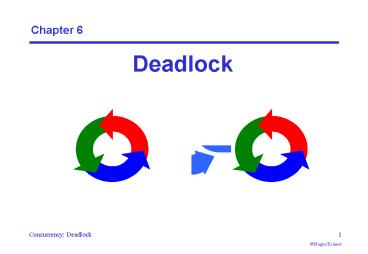Book Chapter 6 PowerPoint PPT Presentation
Title: Book Chapter 6
1
Chapter 6
Deadlock
2
Deadlock
Concepts system deadlock no further
progress four necessary sufficient
conditions Models deadlock - no eligible
actions Practice blocked threads
Aim deadlock avoidance - to design systems
where deadlock cannot occur.
3
Deadlock four necessary and sufficient conditions
- Serially reusable resources
- the processes involved share resources which they
use under mutual exclusion. - Incremental acquisition
- processes hold on to resources already allocated
to them while waiting to acquire additional
resources. - No pre-emption
- once acquired by a process, resources cannot be
pre-empted (forcibly withdrawn) but are only
released voluntarily. - Wait-for cycle
- a circular chain (or cycle) of processes exists
such that each process holds a resource which its
successor in the cycle is waiting to acquire.
4
Wait-for cycle
Has A awaits B
Has E awaits A
Has B awaits C
Has C awaits D
Has D awaits E
5
6.1 Deadlock analysis - primitive processes
- deadlocked state is one with no outgoing
transitions - in FSP STOP process
MOVE (north-gt(south-gtMOVEnorth-gtSTOP)).
- animation to produce a trace.
- analysis using LTSA
- (shortest trace to STOP)
Trace to DEADLOCK north north
6
deadlock analysis - parallel composition
- in systems, deadlock may arise from the parallel
composition of interacting processes.
RESOURCE (get-gtput-gtRESOURCE). P
(printer.get-gtscanner.get -gtcopy
-gtprinter.put-gtscanner.put -gtP). Q
(scanner.get-gtprinter.get -gtcopy
-gtscanner.put-gtprinter.put -gtQ). SYS
(pPqQ p,qprinterRESOURCE
p,qscannerRESOURCE ).
Deadlock Trace? Avoidance?
7
deadlock analysis - avoidance
- acquire resources in the same order?
- Timeout
P (printer.get-gt GETSCANNER), GETSCANNE
R (scanner.get-gtcopy-gtprinter.put
-gtscanner.put-gtP
timeout -gt printer.put-gtP ). Q
(scanner.get-gt GETPRINTER), GETPRINTER
(printer.get-gtcopy-gtprinter.put
-gtscanner.put-gtQ
timeout -gt scanner.put-gtQ ).
Deadlock? Progress?
8
6.2 Dining Philosophers
Five philosophers sit around a circular table.
Each philosopher spends his life alternately
thinking and eating. In the centre of the table
is a large bowl of spaghetti. A philosopher needs
two forks to eat a helping of spaghetti.
One fork is placed between each pair of
philosophers and they agree that each will only
use the fork to his immediate right and left.
9
Dining Philosophers - model structure diagram
Each FORK is a shared resource with actions get
and put. When hungry, each PHIL must first get
his right and left forks before he can start
eating.
10
Dining Philosophers - model
FORK (get -gt put -gt FORK). PHIL
(sitdown -gtright.get-gtleft.get
-gteat -gtright.put-gtleft.put -gtarise-gtPHIL).
Table of philosophers
DINERS(N5) forall i0..N-1 (philiPHIL
phili.left,phil((i-1)N)N.rightFORK
).
Can this system deadlock?
11
Dining Philosophers - model analysis
Trace to DEADLOCK phil.0.sitdown phil.0.right.g
et phil.1.sitdown phil.1.right.get phil.2.sitdo
wn phil.2.right.get phil.3.sitdown phil.3.right
.get phil.4.sitdown phil.4.right.get
This is the situation where all the philosophers
become hungry at the same time, sit down at the
table and each philosopher picks up the fork to
his right. The system can make no further
progress since each philosopher is waiting for a
fork held by his neighbor i.e. a wait-for cycle
exists!
12
Dining Philosophers
Deadlock is easily detected in our model. How
easy is it to detect a potential deadlock in an
implementation?
13
Dining Philosophers - implementation in Java
- philosophers active entities - implement as
threads - forks shared passive entities - implement as
monitors - display
14
Dining Philosophers - Fork monitor
class Fork private boolean takenfalse
private PhilCanvas display private int
identity Fork(PhilCanvas disp, int id)
display disp identity id synchronized
void put() takenfalse
display.setFork(identity,taken) notify()
synchronized void get() throws
java.lang.InterruptedException while
(taken) wait() takentrue
display.setFork(identity,taken)
taken encodes the state of the fork
15
Dining Philosophers - Philosopher implementation
class Philosopher extends Thread ... public
void run() try while (true) //
thinking view.setPhil(identity,view.THINKI
NG) sleep(controller.sleepTime()) //
hungry view.setPhil(identity,view.HUNGRY)
right.get() // gotright chopstick
view.setPhil(identity,view.GOTRIGHT)
sleep(500) left.get() // eating
view.setPhil(identity,view.EATING)
sleep(controller.eatTime())
right.put() left.put()
catch (java.lang.InterruptedException e)
Follows from the model (sitting down and leaving
the table have been omitted).
16
Dining Philosophers - implementation in Java
Code to create the philosopher threads and fork
monitors
for (int i 0 iltN i) forki new
Fork(display,i) for (int i 0 iltN i)
phili new Philosopher (this,i,fork(i-1
N)N,forki) phili.start()
17
Dining Philosophers
To ensure deadlock occurs eventually, the slider
control may be moved to the left. This reduces
the time each philosopher spends thinking and
eating. This "speedup" increases the probability
of deadlock occurring.
18
Deadlock-free Philosophers
Deadlock can be avoided by ensuring that a
wait-for cycle cannot exist. How?
PHIL(I0) (when (I20) sitdown
-gtleft.get-gtright.get -gteat -gtleft.put
-gtright.put -gtarise-gtPHIL when (I21)
sitdown -gtright.get-gtleft.get
-gteat -gtleft.put-gtright.put -gtarise-gtPHIL
).
Introduce an asymmetry into our definition of
philosophers. Use the identity I of a philosopher
to make even numbered philosophers get their left
forks first, odd their right first. Other
strategies?
19
Maze example - shortest path to deadlock
We can exploit the shortest path trace produced
by the deadlock detection mechanism of LTSA to
find the shortest path out of a maze to the STOP
process!
We must first model the MAZE. Each position can
be modelled by the moves that it permits. The
MAZE parameter gives the starting position.
eg. MAZE(Start8) PStart, P0
(north-gtSTOPeast-gtP1),...
20
Maze example - shortest path to deadlock
Shortest path escape trace from position 7 ?
GETOUT MAZE(7).
Trace to DEADLOCK
east north north west west north
21
Summary
- Concepts
- deadlock no futher progress
- four necessary and sufficient conditions
- serially reusable resources
- incremental acquisition
- no preemption
- wait-for cycle
- Models
- no eligable actions (analysis gives shortest path
trace) - Practice
- blocked threads
Aim deadlock avoidance - to design systems
where deadlock cannot occur.

